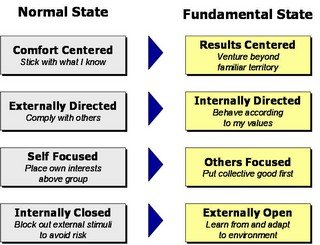A leader grows into the "Fundamental State", according to Robert Quinn, and this is a concept we can apply to President Obama – and any new leader. In Obama's case, we could compare his effectiveness as a campaigner (Normal State) and his effectiveness as a leader now that he is President (Fundamental State). But maybe it's too soon in his leadership, but not too soon in his communications. For we can apply the concept to speaking and communicating as well. We know that effective leaders are usually great communicators – the confidence of leadership often self-evident in confident behavior. This is generally true of Obama, with exceptions noted below.
Robert E. Quinn is a University of Michigan professor who introduced the concept of the Fundamental State of Leadership – a heightened perspective, and one that’s inherent in all of us. Quinn's interesting concept appears in the Harvard Business Review, and it is relevant to business and politics…
“In the normal state people tend to stay within their comfort zones and allow external forces to direct their behaviors and decisions. They lose moral influence and often rely on rational argument and the exercise of authority to bring about change…the result is usually unimaginative and incremental – and largely produces what already exists. To elevate the performance of others, we must elevate ourselves into the fundamental state of leadership.”
We’ve all been there in our personal and professional lives – a time of crisis where we rise to the occasion and overcome the challenge. (For example President Bush leading us during 9/11, but not so much before or after.) If we force ourselves into the Fundamental State, rather than waiting for crisis to knock at our door, we'll get better and better. And so too is the case with communications. Quinn says that getting there requires a shift along four dimensions:

So, what does this mean for us as communicators?
- Don’t stick with what’s comfortable.
Instead of standing in one place behind a lectern during a presentation, move and create energy. Actively pursue speaking engagements that push your comfort zone, where you can practice the behavioral skills of communication.
- Master the Natural Self
– that special combination of your unique personality, mind, opinions and behaviors. Don’t become someone you’re not. Harnessing the Natural Self while communicating will increase your ability to connect with others, because you’re just being you – confident and relaxed.
- Create listener-focused messages. State early and openly the audience’s WIIFM – What’s In It For Me?, action steps and benefits.
- Read cues and adjust.
Practicing is good, but not if you can’t adapt to external cues. Create an experience that’s specific to your audience – whether it’s one person, or one hundred.
Now in President Obama's case, let's hope his Normal State of communications (over dependence on the teleprompter, speaking in what I call 'Obama bursts', many 'ums' and 'ahs' in interview settings) will transform into the Fundamental State, where he can communicate more openly and skillfully, even though in unfamiliar territory.
These are great tips to being an effective communicator and leader. It is important to exude ones self, because leadership comes from within.
Thanks!
It’s interesting but that really does frame (not that I’m saying I’m a leader), changes in mental state when you get put in positions where people look to you to lead and the differences in our behaviour.
An enjoyable site and post. Your Bookmarked!